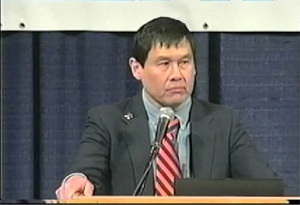Floods. Fires. Snow and ice storms. Earthquakes and epidemics. Terrorist attacks. Emergencies happen. In fact, according to FEMA , we've had 69 disasters this year already, in the United States -- 43 of them in Washington and 23 in Oregon.
Oregon Rep. David Wu is leading an effort to improve our ability to predict and prepare for natural hazards. Chairing a hearing in the Science Subcommittee on Technology and Innovation last week, Wu called for a coordinated approach to all disaster research funding.
"Wind and fire cause approximately $28 billion worth of damage and kill an average of 4,350 Americans each year," Wu said. "The key to successful mitigation of any and all potential hazards is a coordinated and effective public education program."
Wu is advocating for a single hazards mitigation program to fund research into wind, fire, earthquakes, tsunamis and other disasters, instead of the current piecemeal funding system.
Disasters, whether natural or manmade, can cause tremendous damage, destruction and death. Nobody can predict when a disaster will strike, or exactly who will suffer.
But using the data we have collected over time, experts can predict the kinds of disasters that are most likely to happen and where. Nationally, for example Texas, California and Oklahoma and Florida rank one to four in the list of disaster prone states. Washington state is ranked number 20 with 43 emergencies declared so far this year while Oregon ranks number 33 with 23 declared disasters.
Few of us want to spend our lives worrying about disasters that probably will never happen. Yet we are told everyone should be prepared to cope in an emergency. So what kind of disasters are likely to happen in the Northwest?
In both Washington and Oregon states, the record tells us that the most likely natural disasters are winter storms, floods, mudslides and fires, Earthquakes and droughts are rarer although potentially even more devastating. Multnomah County's 2005 hazard mitigation assessment mapped the areas most vulnerable to natural disasters. That included flooding in low-lying areas of Portland and fires in natural areas such as Mock's Crest. King County's emergency management site lists 16 hazards from avalanches and power outages to hazardous materials spills.
Which potential danger would hurt Northwest residents the most? According to the State of Oregon's 2006 hazard analysis and mitigation plan, the three potentially most devastating natural disasters, would be of disaster prone states. Washington state is ranked number 20 with 43 emergencies declared so far this year while Oregon ranks number 33 with 23 declared disasters. Few of us want to spend our lives worrying about disasters that probably will never happen. Yet everyone should be prepared to cope in an emergency. So what kind of disasters are likely to happen in the Northwest?In both Washington and Oregon states, the record tells us that the most likely natural disasters are winter storms, floods, mudslides and fires, Earthquakes and droughts are rarer although potentially even more devastating. Multnomah County's 2005 hazard mitigation assessment mapped the areas most vulnerable to natural disasters. That included flooding in low-lying areas of Portland and fires in natural areas such as Mock's Crest. King County's emergency management site lists from avalanches and power outages to hazardous materials spills. Which potential danger would hurt Northwest residents the most? According to the State of Oregon's 2006 hazard analysis and mitigation plan, the three potentially most devastating natural disasters, would be
A major earthquake
A tsunami, or
A volcanic eruption.
The last time a large earthquake hit the Pacific Northwest was in the year 1700, said John Vidale, director of the Pacific Northwest Seismic Network. "A big earthquake of magnitude nine comes about once every 500 years, so we have a 10 percent chance of seeing one in the next 50 years."
Video |
A former UCLA professor, who is now Washington State Seismologist, Vidale says studies of Seattle and Portland suggest that Seattle would suffer more damage than previously thought if an earthquake hit the Puget Sound area. "We're thinking that Seattle is more dangerous than we had thought because of the big basin in the Puget Sound," he said. "Portland seems like it may be less in danger than we had thought." However, he said, "If a six occurred in Portland it could do a lot of damage."
Vidale said the good news is that better seismometers and more careful studies have improved our ability to predict and warn citizens of an approaching earthquake.
The risk of a coastal tsunami is similar to risk of an earthquake. In fact tsunamis are caused by earthquakes under the ocean floor. All coastal areas could be affected.
Man made disasters, such as terrorist attacks, chemical spills and radiation leaks, are more difficult to predict. But experts say that families and businesses who prepare for a natural disaster will be prepared for any kind of disaster. The keys to being prepared are to make a plan for what you would do if:
Your family was separated when a disaster struck
You had to stay in your home for several days
Your home had no power or water supply
Local telephones won't work
Roads were closed
Shops and pharmacies were closed















































































































































































































































































































